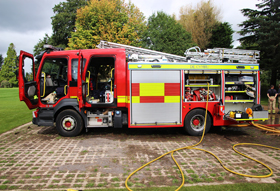
Foam in the News - Rescue training

Aside from the conventional uses of foam in furniture, mattresses and industrial settings, its versatility means that it also has many unthought-of and unconventional uses. It is already common knowledge that foam blocks are used in foam pits to ensure the safety of gymnasts, BMX and skateboard stunt riders, and the general public in trampoline parks. However, foam is an excellent material that also assists with the training of emergency services personnel.
A recent US news story unveiled how rescue teams, firefighters and paramedics train for a number of rescue situations. Most significantly, it revealed the use of foam pits – of various foam shapes cut to size – to assist with training for complex rescue operations. The dense yet malleable nature of the foam used meant that practising in a foam pit enabled rescue workers to practise manoeuvring a person in difficult environments, and more significantly, how to rescue them safely if the individual had sustained injuries.
By using foam pits, emergency and rescue personnel are able to practise the steady removal and movement of a patient on a rigid spinal board. The foam cubes (or indeed, any shape they may be) encourages the rescue personnel to carefully navigate their own movements to ensure a steady rescue. This includes learning how to perfectly co-ordinate their movements with fellow teammates to maintain both a steady balance and a grip of the patient on the spinal board. Different grades, types and shapes of foam effectively equate to practising a rescue with varying levels of difficulty. The denser the foam and the higher the number of foam cubes compacted in a pit, the easier the movement of staff and subsequent rescue.

The most popular type of foam typically used in these training pits is high-density polyurethane. A durable, specialist foam, this grade and type will be better resistant against damage to the various objects it will encounter during a practise rescue – solid hard shoes, plastic and metal of the spinal board, and any other equipment such as ropes, chains and carabiners that may accidentally be pushed into the foam with reasonable force. With its firmer feel, it offers a reasonable yet challenging level of control for those in practise. Furthermore, it is also this firmer density that is better suited to protecting rescue equipment from unnecessary damage during trial rescues scenarios.
For rescue teams that need to practise in a more challenging environment, there are two options to increase the level of difficulty. The first is that the size of the foam cubes used can be made smaller. In turn, this makes for a more uneven and unbalanced surface, increasing the difficulty of both navigation and balance. Alternatively, low-density foam can be used, making the surface underfoot far more malleable and unsteady as a result. However, using lower-density foam may mean that the pits’ resistance to wear and tear may not be as strong as that of a higher density material. With this in mind, it is worth taking into account the potential damage to foam that can be caused by the type and range of equipment used during practice.
At eFoam, we are experts in the provision of foam for commercial, personal and industrial use, including the medical sector. Should you require any more information on foam grades, types and shapes, please contact one of our friendly representatives.

